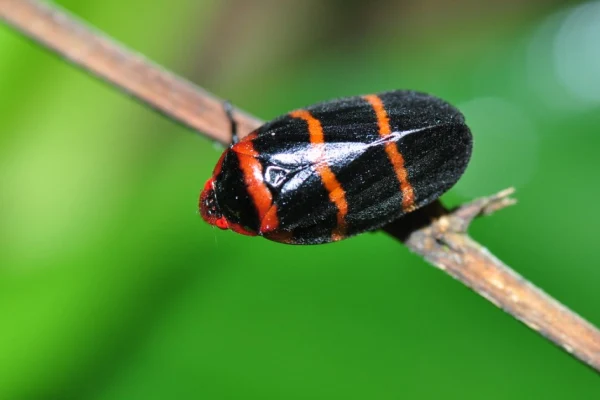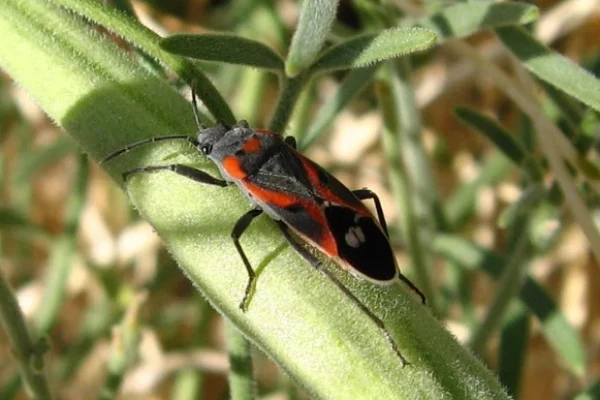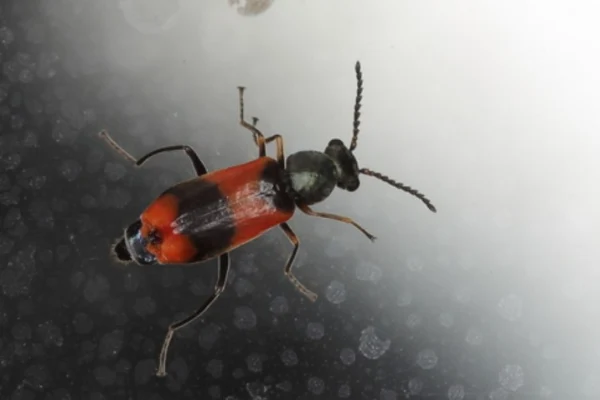What comes to mind when you hear a black bug with orange stripes? Most probably the Boxelder bug. But there are many black bugs with orange stripes that are present in nature and are quite uncommon.
In this article, we are going to see these uncommon bugs. So here is the list of 10 uncommon black bugs with orange stripes.
10 Uncommon Black bugs With Orange Stripes
1. Two-lined spittlebug

|
Scientific name |
Prosapia bicincta |
|
Size |
8 to 10 mm |
|
Geographical Location |
Eastern United States |
|
Identification |
Have two horizontal orange stripes on their black elytra. |
The first bug we have on our list is the two-lined spittlebug. As their names suggest, two horizontal orange stripes are present on their black elytra, which makes them distinct.
These red-eyed bugs are 8 to 10 mm in length. Beetles in their juvenile stage produce spittle foam, which protects them from predators.
One can commonly find them in North America during the summer. Their nymphs are considered pests for grasses like truffle grass.
2. California Bordered plant bug
|
Scientific name |
Largus californicus |
|
Size |
up to 1 inch |
|
Geographical Location |
North America and Central America |
|
Identification |
have orange stripes on the margins of their wings |
These black bugs are commonly found in the Western United States, primarily in California. These beetles got their name from their appealing appearance.
They have orange stripes at the margins of their black wings. Their adult forms are very similar to their younger ones.
They usually feed on the liquid portion of fruits and vegetables with their sucking mouth parts. This California native species can grow up to 1 inch.
3. Small milkweed bug
|
Scientific name |
Lygaeus kalmii |
|
Size |
10 to 12 mm |
|
Geographical Location |
Central and North America |
|
Identification |
X-shaped orange mark on elytra |
The next black bug is Lygaeus kalmii, which belongs to the family Lygaeidae. One can identify them easily by the orange X mark on their elytra, which is formed by crossing two orange stripes.
These small organisms, which hardly reach 1/2 inch, can grab attention with their incredible appearance.
They are commonly found in the United States and Canada. As their name indicates, they feed on milkweed seeds, which makes them toxic.
4. Western Boxelder bug

|
Scientific name |
Boisea rubrolineata |
|
Size |
9 to 13 mm |
|
Geographical Location |
Western North America |
|
Identification |
have a black body with three orange or red stripes |
Let’s talk about a typical black bug with orange stripes that is a western boxelder bug. These bugs are almost black, with three orangish-red stripes on their wings.
They got their name from their preference to eat Boxelder tree fruits or sap. They cause damage to the orchard trees, primarily pear, kiwi, etc.
You can find this western North American native species inside your houses during their hibernating time period.
5. Striped Blister beetle
|
Scientific name |
Epicauta vittata |
|
Size |
9 to 17 mm |
|
Geographical Location |
Eastern North America |
|
Identification |
have three vertical orange stripes on their black elytra |
This agricultural pest, Epicauta vittata, is commonly found in eastern North America.
This medium-sized beetle can reach up to 9 to 17 mm in length during its adult stage. Striped blister beetle or old-fashioned potato beetle are some of the common names for this species.
They are black with two or three orange stripes and have an orange head. These voracious feeders also act as vectors for the transfer of bean pod mottle virus.
6. Goldenrod leaf miner beetle

|
Scientific name |
Microrhopala vittata |
|
Size |
5 to 7 mm |
|
Geographical Location |
United States and Southern Canada |
|
Identification |
Have a black body with two orangish red stripes |
This uncommon black bug of the family Chrysomelidae is found commonly in the United States and southern Canada. This keystone species has a black body with a pitted thorax and two red orangish stripes running along its elytra.
Their name suggests that they usually feed on golden rod leaves. The females of golden rod leaf miner beetles lay up to eight clutches underside the leaves.
The most interesting thing about these beetles is that their larvae are leaf miners and feed on the upper and lower sides of leaves, leaving the channel inside the leaves.
7. Twice stabbed stink beetle
|
Scientific name |
Cosmopepla lintneriana |
|
Size |
3.75 to 5 mm |
|
Geographical Location |
North America |
|
Identification |
Have orange spots on the middle of their elytra |
Let’s continue this list of black bugs with orange stripes with a twice-stabbed stink beetle. They are commonly known as stink bugs due to the foul smell they produce.
These polyphagous species feed on a variety of plants, including milkweed, milk thistle, echinacea, asparagus, oats, mint, and goldenrod. These small beetles are found all across North America.
They have a black body with two characteristic orange spots on their scutellum and an orange stripe on their wings. They are mostly active during the spring season.
8. Eurasian red and black melyrid

|
Scientific name |
Anthocomus equestris |
|
Size |
9 to 15 mm |
|
Geographical Location |
North America |
|
Identification |
have broad orange stripes on their metallic black body |
Eurasian red and black melyrid is the common name of the bug Anthocomus equestris which belongs to the family Melyridae. This European native species is now widespread in North America.
They are often mistaken for red and black blister beetles due to their similar appearance. They are metallic green or black in color and have broad orange stripes on their black elytra.
Their adults are solely herbivorous, whereas their larvae feed on other small insects.
9. Pyrota akhurstiana
|
Scientific name |
Pyrota akhurstiana |
|
Size |
12 to 21 mm |
|
Geographical Location |
North America |
|
Identification |
have two orangish red stripes on their black body |
Pyrota akhurstiana is a blister beetle in the Meloidae family. This North American native species inhabits a variety of habitats from Arizona to Texas. They are medium-sized, with an average length of 12 to 21 mm.
They primarily act as pests on alfalfa in New Mexico and are known to attack the flowers of Garita. You can find them flying in July and August.
10. Red Bull Assassin Bug
|
Scientific name |
Repipta taurus |
|
Size |
11 to 13 mm |
|
Geographical Location |
Central and North America |
|
Identification |
have projecting spines on their thorax |
Red Bull Assassin bugs are known for their ambushing ways to predate. This bug got its name due to the presence of projecting spines on its thorax.
They are small as compared to the above beetles and can attain a length of up to 11 to 13 mm. They are commonly found in the United States and Panama.
The dorsal side of this bug is black with orange stripes on the margins, and it has a typical orange head.
This marks the end of our article. Despite being uncommon, these bugs have a role in the ecological system. I sincerely hope you find it insightful. We’ll be back shortly with a new article.
Also Read:

Being a zoology student I’m always been fascinated toward animals especially insects. I love to do research and learn about different animals. As a writer I want to share my thoughts about nature through my articles. Apart from this you can find me exploring the new places and voice notes.
